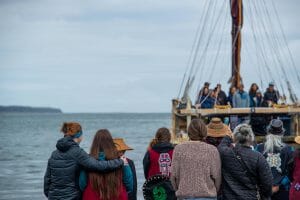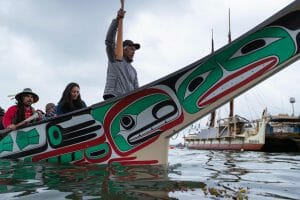Join Sealaska as we welcome and bid farewell to Hōkūle’a and our Hawaiian relatives of the Polynesian Voyage Society (PVS) while they embark on the Moananuiākea Voyage, a four-year journey across the pacific, from the stores of our ancestral homelands. 
A tribal welcome ceremony will take place on Saturday, June 10 from 3-7 p.m. at the Auke Rec Raven Shelter, kicking off a week-long series of events and festivities in Juneau that will culminate the Global Launch of the Moananuiākea on Thursday, June 15 from 3-7 p.m. at the same location, and will be live streamed via MySealaska for those who unable to attend in-person.
Please note that welcome ceremony and global launch attendees must park at the University of Alaska Southeast (UAS) campus in Auke Bay, from where Sealaska will provide shuttles to and from the event. The road to the recreation center will be closed to traffic for both events.
At Sealaska, we are deeply honored to be a part of the launch of Moananuiākea and the story of the Hōkūle’a, the traditional Polynesian voyaging canoe that will carry the crew 43,000 nautical miles to 36 countries and archipelagoes, and nearly 100 indigenous territories.
Continue reading to learn more about Sealaska’s connection to generations of navigators at PVS, the Moananuiākea Voyage and why it matters for our planet and oceans.
A story of kinship:
Cultural connection between Southeast Alaska and Hawai’i goes back thousands of years, rooted in ancient relationships built and nurtured by our ancestors. But that sense of unity evolved into a deeper bond in 1990, when PVS set out to build a double -hulled canoe, or wa’a kaulua, using traditional materials. They scouted for trees in their vast koa, but many parts of the island had been deforested to an extent that threatened ecosystems — there were no longer any trees healthy or large enough to build a vessel for long-distance voyaging.
That’s when Sealaska, under the leadership of the late Byron Mallot, gifted two 200-foot Sitka spruce logs from Xaadaas territory near Prince of Wales Island to Hawai’i, providing our relatives with the cherished makings of the Hawai’iloa voyaging canoe. Five years later, PVS returned to Alaska on a journey of reunion and gratitude with the Hawai’iloa.
Today, we continue to foster the collective admiration, care and fellowship between our Tlingit, Haida and Tsimshian people and our Hawaiian relatives. The honor of launching Moananuiākea from the lands and waters we call home will bring us together as family once again, marking the start of a voyage that will inspire people far and wide to take greater care of our planet, and each other.
A voyage for earth:
At the core of Hōkūleʻa’s creation was a reignited sense of exploration – to uncover, recover and reclaim the wisdom and spirit of ancestors, and the culture and tradition passed down through them. Moananuiākea is no different, but its leaders are now guided by something greater: values like mālama, or caring, and kuleana, taking responsibility. They have been called to move from discovery toward stewardship and build a better future for our children and grandchildren.
The Moananuiākea voyage will coincide with a global educational campaign to share with millions of people traditional knowledge about life systems on earth and the vital role of healthy oceans, ultimately inspiring an ethos of mālama and kuleana for the planet we call home and the future generations that depend on it. 
Its leaders and crew predict that Moananuiākea will be the most difficult voyage yet — “because the destination is not ours,” PVS wrote. “It [the destination] will be the hardest to find, because it is the future of earth.”
To learn more about Sealaska’s historical relationship with the Polynesian Voyaging Society, explore the links below: